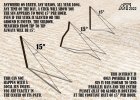Pertti Niukkanen
Active Member
Here's the homemade test I suggested above. The idea is to observe the tip of the shadow of a stick etc. and mark its location every hour. The stick does not have to be straight or even completely vertical. The platform does not have to be completely horizontal either, but it must be flat for the follow-up test.

Picture 1 shows my version from a year ago. It had a miniature flagpole as a stick, the tip of which cast a shadow on the flat table. I marked the tip of the shadow with a marker on the table every hour.
Figure 2 shows the expected result of an experiment conducted at the vernal equinox. If you tighten the (red) threads from the tips of the shadows to the tip of the stick, you can see that the angles between the threads are all 15°. In addition to this, the tips of the shadow line up.
Especially the latter result is fatal for FE theory. The Sun rotating in a circle above the flat Earth cannot possibly produce such a straight line. The tip of the shadow should draw a circle.
(Admittedly, I did nothing but the latter test myself at that time, which succeeded as expected. I was too lazy to measure the angles. I hope you find an easy way to measure them.)
Figure 3 shows a similar test done on the summer solstice. In this case, the angles between the wires should be 13.76°. (You can probably be satisfied if you get a result of approx. 14°.) Now the tips of the shadow do not draw a straight line, but settle on an arc, which, strictly speaking, is a hyperbola.
Figure 4 shows an experiment done on the winter solstice. Even then, the angles between the threads are 13.76°. Even now, the tips of the shadow are placed on an arc, which is a hyperbola. This time it just opens in the opposite direction as in experiment 3. This is even more impossible in the FE model.
Picture 1 shows my version from a year ago. It had a miniature flagpole as a stick, the tip of which cast a shadow on the flat table. I marked the tip of the shadow with a marker on the table every hour.
Figure 2 shows the expected result of an experiment conducted at the vernal equinox. If you tighten the (red) threads from the tips of the shadows to the tip of the stick, you can see that the angles between the threads are all 15°. In addition to this, the tips of the shadow line up.
Especially the latter result is fatal for FE theory. The Sun rotating in a circle above the flat Earth cannot possibly produce such a straight line. The tip of the shadow should draw a circle.
(Admittedly, I did nothing but the latter test myself at that time, which succeeded as expected. I was too lazy to measure the angles. I hope you find an easy way to measure them.)
Figure 3 shows a similar test done on the summer solstice. In this case, the angles between the wires should be 13.76°. (You can probably be satisfied if you get a result of approx. 14°.) Now the tips of the shadow do not draw a straight line, but settle on an arc, which, strictly speaking, is a hyperbola.
Figure 4 shows an experiment done on the winter solstice. Even then, the angles between the threads are 13.76°. Even now, the tips of the shadow are placed on an arc, which is a hyperbola. This time it just opens in the opposite direction as in experiment 3. This is even more impossible in the FE model.

